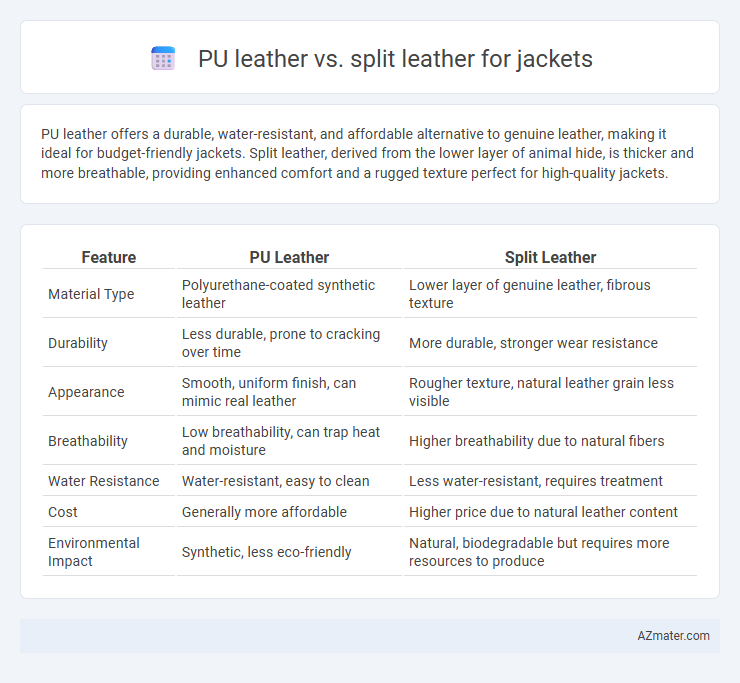PU leather offers a durable, water-resistant, and affordable alternative to genuine leather, making it ideal for budget-friendly jackets. Split leather, derived from the lower layer of animal hide, is thicker and more breathable, providing enhanced comfort and a rugged texture perfect for high-quality jackets.
Table of Comparison
| Feature | PU Leather | Split Leather |
|---|---|---|
| Material Type | Polyurethane-coated synthetic leather | Lower layer of genuine leather, fibrous texture |
| Durability | Less durable, prone to cracking over time | More durable, stronger wear resistance |
| Appearance | Smooth, uniform finish, can mimic real leather | Rougher texture, natural leather grain less visible |
| Breathability | Low breathability, can trap heat and moisture | Higher breathability due to natural fibers |
| Water Resistance | Water-resistant, easy to clean | Less water-resistant, requires treatment |
| Cost | Generally more affordable | Higher price due to natural leather content |
| Environmental Impact | Synthetic, less eco-friendly | Natural, biodegradable but requires more resources to produce |
Introduction to PU Leather and Split Leather
PU leather, a synthetic material made by coating fabric with polyurethane, offers water resistance and easy maintenance, making it a popular alternative to genuine leather jackets. Split leather, derived from the fibrous layer underneath the top grain of animal hides, provides a more rugged texture and durability but often requires more care and treatment to prevent wear. Both materials serve different aesthetic and functional needs, influencing jacket choice based on longevity, appearance, and price.
Material Composition: PU Leather vs Split Leather
PU leather is a synthetic material composed primarily of a polyurethane coating applied over a fabric backing, offering a consistent texture and water resistance ideal for jackets. Split leather comes from the lower layers of a hide, made by splitting the original grain layer, and is typically less durable and breathable than full-grain leather but provides a more affordable option with a suede-like finish. The choice between PU leather and split leather for jackets hinges on the preference for synthetic durability and uniform appearance versus natural fiber content and texture variability.
Durability Comparison
PU leather jackets offer moderate durability, being resistant to water and stains but prone to cracking and peeling over time due to their synthetic composition. Split leather jackets, derived from the fibrous lower layer of animal hide, provide enhanced durability with better resistance to wear, stretching, and abrasion, making them more suitable for long-term use. While split leather requires proper care to maintain its strength, it generally outperforms PU leather in longevity and toughness for jacket applications.
Appearance and Texture Differences
PU leather offers a smooth, uniform appearance with a consistent texture that mimics genuine leather while maintaining a synthetic finish. Split leather, derived from the fibrous part of the hide beneath the outer layer, showcases a more natural, rugged look with a slightly rougher texture that highlights its organic origin. The visual and tactile contrast between PU leather's polished surface and split leather's raw, porous feel significantly influences the jacket's style and durability.
Comfort and Breathability
PU leather offers a smooth, consistent texture with limited breathability, making it less comfortable for prolonged wear compared to split leather. Split leather, derived from the fibrous part of the hide, provides better airflow and flexibility, enhancing comfort in jackets. Both materials vary in durability, but split leather generally allows superior breathability suitable for extended use.
Maintenance and Care Requirements
PU leather jackets require gentle cleaning with a damp cloth and mild soap, avoiding harsh chemicals to prevent surface cracking and peeling. Split leather jackets demand more intensive care, including conditioning with leather-specific products to maintain suppleness and prevent drying or cracking. Proper storage away from direct sunlight and moisture is essential for both materials to extend jacket lifespan.
Cost and Affordability
PU leather jackets are significantly more affordable than split leather due to lower production costs and synthetic materials, making them ideal for budget-conscious buyers seeking stylish outerwear. Split leather jackets, derived from the fibrous inner layer of animal hides, tend to be pricier because of their durability, natural texture, and higher quality finish. Those prioritizing cost-effectiveness often opt for PU leather, while customers willing to invest in long-lasting leather typically choose split leather jackets.
Environmental Impact
PU leather, a synthetic material made from polyurethane, has a lower environmental impact during production compared to traditional leather, as it requires fewer natural resources and avoids animal cruelty. Split leather, derived from the fibrous part of animal hides, involves more intensive resource use, including water, chemicals, and energy, and contributes to the environmental issues associated with livestock farming such as greenhouse gas emissions. Choosing PU leather reduces reliance on animal agriculture and minimizes waste, but it still poses challenges due to microplastic pollution and non-biodegradability.
Suitability for Jackets
PU leather offers a sleek, water-resistant surface that maintains a consistent appearance, making it ideal for fashion-forward jackets requiring a polished look and easy maintenance. Split leather, derived from the lower layers of hides, provides a more breathable and durable option with a rugged texture, suited for jackets designed for heavy use and enhanced ventilation. Choosing between PU leather and split leather depends on whether style and water resistance or durability and breathability are prioritized in jacket construction.
Which Leather Should You Choose?
PU leather offers a cost-effective, durable, and water-resistant option ideal for fashion-conscious buyers seeking low maintenance, while split leather provides a softer, more breathable texture with enhanced comfort and natural aging for those prioritizing authenticity. Split leather jackets, made from the inner layers of animal hides, exhibit superior breathability and a unique patina over time, making them a preferred choice for durability and style longevity. Choosing between PU leather and split leather depends on whether you value affordability and easy care or natural texture and lasting wear in your jacket.

Infographic: PU leather vs Split leather for Jacket
 azmater.com
azmater.com